The layout of residential development and the placement of ancillary buildings on the territory are determined by construction standards and rules. Many car owners believe that on plots near private houses they can build a garage structure anywhere. This is wrong. To erect permanent buildings on land for individual housing construction and personal subsidiary plots, it is sometimes necessary to obtain permission. It is necessary to comply with the regulations for the construction of a garage on the site.
Do you need documents to build a car garage?
If the car owner intends to use the garage only for personal purposes, there is no need to apply to the local administration for permission. Regulated by Art. 51 of the Town Planning Code of the Russian Federation.
If the arrangement of a garage structure is intended for doing business, contact the town planning department of the local municipality with an application. Specialists will visit the site to determine whether construction work can be carried out. The landowner must present:
- Title documents for land.
- General plan of the building.
- Relief plan.
- Scheme of engineering networks.
When a garage box is built on your own land for personal use, fire and sanitary requirements are strictly followed.
Some subtleties of the issue
Is it possible to build a car garage on an area bordering a road?
The requirements should not be violated. A car garage built on the border with the roadway may cause disputes from neighbors. They can prove that the structure would prevent a fire truck from turning around to approach them. The court will order the dismantling of such a building.
This is interesting: Boundaries of buildings on a plot of land
Possibility of erecting a box on the border with the alley
According to the Code of Rules 42.13330.2011, any auxiliary outbuilding (including a car garage) located in the local area must be located from the border of the site, maintaining a distance of 1 meter. The joint venture allows outbuildings on neighboring territory only with the consent of the neighbors. Otherwise, the court will make a decision to demolish the building if the owner does not move it 1 meter from the border of the UZ.
If the owner of a nearby house has violated the requirement, they file a statement with the fire department outlining their claims. Be sure to make a reference to the Federal Law “Technical Regulations on Fire Safety Requirements” No. 123 of July 22, 2008.
Construction on the lane line
In accordance with the provisions of the Code of Rules SP 42.13330.2011 “Urban planning. Planning and development of urban and rural settlements”, outbuildings of an auxiliary nature must be located at a distance of 1 m from the boundaries of the site.
Please note! The garage is one of the auxiliary buildings, therefore, these standards apply to it.
The construction of blocked buildings is allowed, but the consent of the neighbor must be obtained.
In the absence of appropriate consent, the court makes a decision to recognize the construction as unauthorized. It is subject to demolition if its owner does not move it to the permitted distance.
If the violation was committed by your neighbor, file a report with the fire department.
To substantiate the stated facts and requirements, use the provisions of the Federal Law of the Russian Federation of July 22, 2008 No. 123-FZ “Technical Regulations on Fire Safety Requirements.”
Construction of a capital house in SNT.
What to do if your neighbor's garage has encroached on your property
Many people face the problem when a neighbor's garage is partially located on their land. This happens when buying real estate. If the owner has completed all the documents for the purchased house and plot and is confirmed by an extract from the Unified State Register, he has the right to demand that his neighbor dismantle the garage box on a voluntary basis. If the owner of the neighboring territory does not remove the structure within the specified period after receiving a written notice, they file a claim in court.
In Russia, documents have been adopted regulating the correct development of plots that are privately owned by citizens. If you strictly follow all legal standards when building a garage on a plot of land, you will not have any troubles with the authorities and neighbors due to improper placement of the facility. Building codes and regulations are regularly updated and supplemented with new construction techniques. They need to be studied before carrying out work.
At what distance from the fence can a garage be built: SNiP norm and law
When placing a permanent garage for your favorite car on the site, you need to take into account existing standards. To exclude claims from government agencies and neighbors, you should know at what distance from the fence you can build a garage. It is necessary to determine in advance the list of permits and the procedure for constructing buildings of this type. This will help to avoid complaints and problems upon completion of the construction of a garage next to the fence due to non-compliance with distance standards, rules and legal requirements.
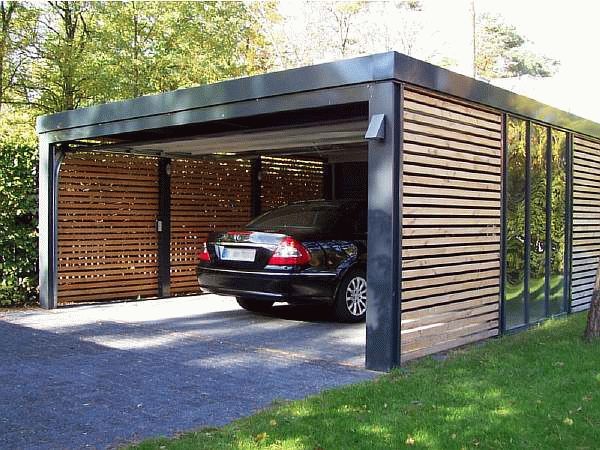
At what distance does the law allow garages to be built from fences?
Registration of land as private property is an important document, but it does not give the right to build where you want and how you want. When constructing a garage, it is necessary to formalize the construction project at the legislative level, obtaining the consent of the neighbors. This is done if it has to be fit into an already finished building. It is easier to do this at the stage of building a house. In both cases, you need to study the relevant regulatory documents, which detail at what distance from the fence you can build a garage and strictly follow them. Based on the requirements of SNiP, its location along the boundaries of the facade should be as follows:
- at least 1 m from plants;
- 2 m from medium-sized trees;
- 4 m away from tall plants (meaning trees);
- no closer than 1 from buildings for economic purposes;
- 3 from a residential building, 15 from a wooden house.
According to the same document, the garage is considered an outbuilding, so its boundaries in relation to the boundaries of the fence should be at a distance of 1 meter. The diagram below shows the intervals at which all outbuildings should be erected.
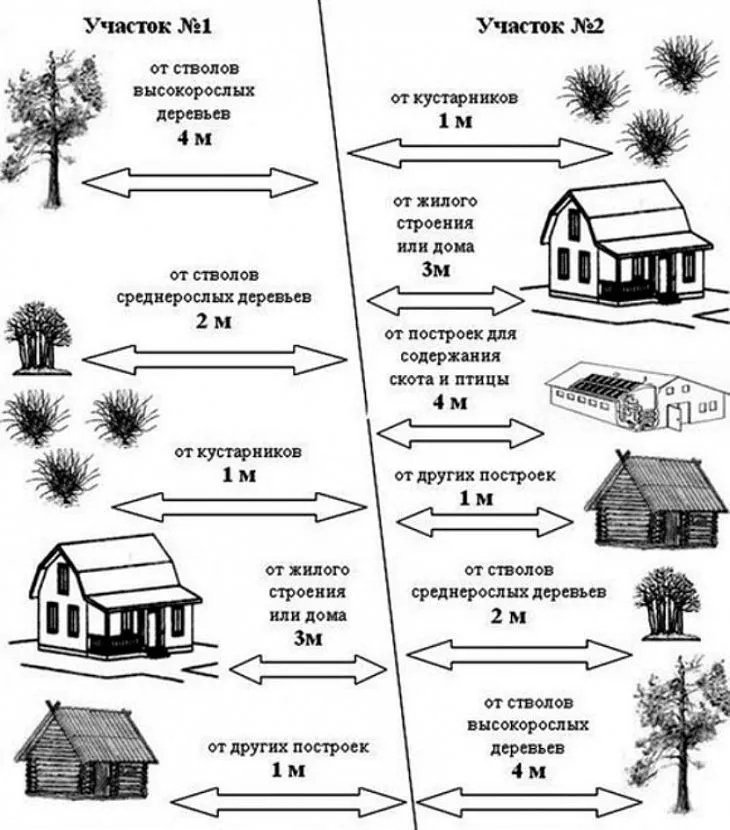
Basic rules governing the placement of buildings relative to each other Source doka-metal.ru
See also: Catalog of companies that specialize in the construction of fences and fences.
Additional SNiP requirements include:
- Distance from the entrance to the yard. Driving through the territory should not be turning.
- Groundwater level. The owner who is building a garage with a cellar or inspection pit should know this parameter.
- Relief. The building site must be located on a hill and be insured against the drainage of melt water and precipitation.
- Built-in garage type. If such a project is chosen, then living rooms should not be located above this building. It is allowed to place a library, a study and other premises above the garage in which a person is located temporarily and not permanently.
- Distance from neighbors. This gap should be of such a size that the garage structure does not shade the neighbor’s house during the day. Drains must be placed strictly towards your own site. The permissible distance from the neighbors’ house is 6 m.
Some deviations from these standards are possible, but they will definitely need to be approved by the relevant authorities.
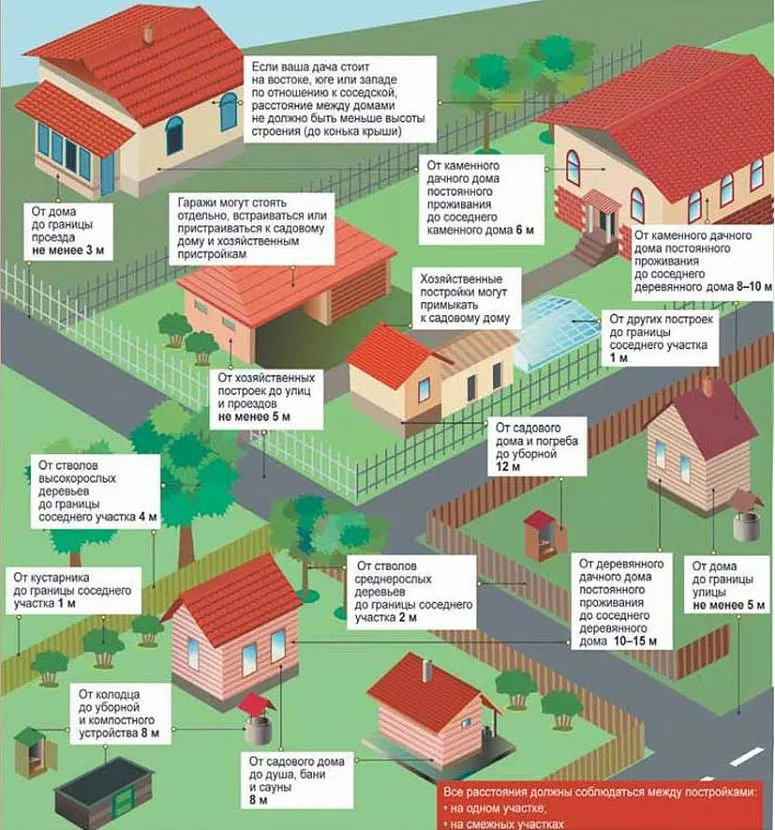
Distances between buildings on the same and adjacent sites Source doka-metal.ru
Advice! To save the size of the site, you can install not traditional (swing) gates, but roller or sectional ones. It is very important not to violate the integrity and harmony of the architectural ensemble.
Regulatory restrictions
The construction of main and auxiliary buildings must be carried out without violating building codes and regulations (hereinafter referred to as SNiP), which take into account technical, legal and economic requirements in relation to architectural surveys and urban planning.
In order to be able to register a new building as an object of real estate owned, it is necessary to obtain the appropriate permission.
An exception is represented by a combination of the following circumstances:
- Construction of a garage is not associated with the desire to make a profit from rental activities, vehicle repairs and other things.
- They plan to install the box on land owned by the owner, allocated for housing construction or non-profit gardening activities (SNT or dacha cooperative).
- The box does not have a foundation, for example, a metal one, therefore, it does not belong to capital construction projects.

In all other cases, the owner of the site is obliged to contact the architectural department of local authorities, submitting the following documents:
- a written statement with mandatory information (from whom, to whom, circumstances and essence of the request);
- a copy of the identity document of the owner of the land plot;
- document confirming land ownership;
- topographic reference to the area;
- cadastral plan of house construction and adjacent territory;
- technical documentation with BTI assessment information;
- scheme for entering communications into the housing construction area;
- project.
Having received the application, the official is obliged to issue a receipt to the applicant stating that the documents have been accepted for consideration. The decision on whether it is possible to build a garage in the declared location is made within ten working days. In practice, this procedure takes longer.
If a negative decision is received, all documents must be returned. The applicant has the right to re-submit a petition to the same body after changing the construction plan or may appeal to the courts to appeal an administrative, in the opinion of the applicant, unlawful refusal.
President of the Interregional Legal Center for Land Relations LLC Ekaterina Ivanova answers:
Formally, this issue is not regulated in the town planning code of the Russian Federation. It is only indicated that the construction of a garage does not require obtaining a building permit. However, the concept of buildings and structures for auxiliary use is mentioned. Auxiliary is one that serves the main structure. And it is logical that the area of the auxiliary building should not exceed the area of the main (residential building).
When planning the development of a site, you need to take in advance an extract from the Land Use and Development Rules in a particular municipality or an urban planning plan for the land plot. It must indicate the permissible height regulations and the construction area of the main and auxiliary buildings.
Is it worth getting a garage?
How to protect your garage from demolition?
If we are talking about building a garage on private land, it does not matter when (or whether) a residential building is built on it. But if a garage is being built for the purpose of purchasing land leased from the state, the purchase of the plot will be refused, since the purpose of providing the plot for rent, namely the construction of a residential building, has not been achieved.
If the area of the garage is larger than the area of the house, the risks that the municipality will recognize such a construction as unauthorized are not very large - there are many other problems. However, firstly, it will be impossible to register it as property. And, secondly, if a good neighbor writes a complaint that this garage is a big nuisance to him, then government agencies will be obliged to respond and consider the complaint with an investigation of all the circumstances of the case. Therefore, it is better to avoid situations where the garage area is larger than the area of the house, and even more so to observe the minimum dimensions from the walls of the garage to the neighboring area. Minimum - 1 meter; in some municipalities it is more.
Removal from objects
Obtaining a building permit largely depends on compliance with SNiP requirements in the construction project, in particular, whether the minimum permitted distances to courtyard buildings, neighboring houses and infrastructure facilities are observed during the construction of a garage.
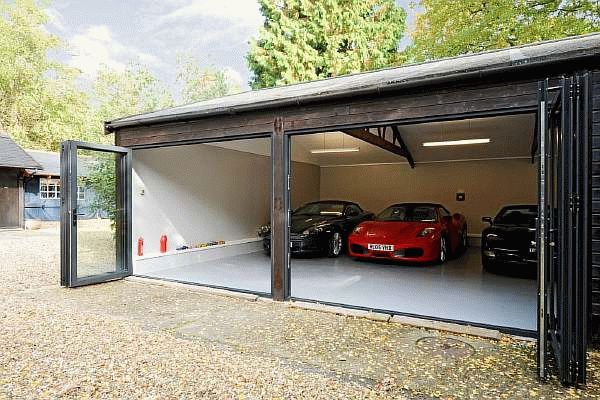
SNiP norms for 1997 prescribe the following for outbuildings, which include car premises:
- distance from residential buildings if the garage is attached - 3 m;
- distance to other outbuildings (barn, separate attic, etc.) from 1 m;
- distance from the fence to the garage from 1 m;
- the sector to the bush is at least 1 m;
- distance from trees of moderate growth from 2 m;
- the distance between the extension and tall trees is from 4 m;
- the distance to the neighbor’s residential building is at least 6 m;
- to the “red line” (the border of private households and municipal land) more than 5 m.
A garage cannot be built close to a fence. It is necessary to make 1 meter indentations from the neighbors' fence.
Restrictions on the specific placement of the car box and the functioning of its individual structural elements:
- If the garage is attached to the house, then the distance to the nearest building should be at least 3 m.
- When placing the box with the gate facing the street, a distance of 3 meters from the road must be maintained.
- The distance from the garage to the roadway in villages and cities is at least 5 m, while the distance is calculated from the base of the building or roof if its protrusion exceeds 0.5 m.
- If one of the sides is adjacent not to the neighbor’s fence, but to an alley, then the distance to the road should be less than 3 m.
- Installation closer than two meters to a power line support is not allowed.
Violation of SNiP regulations in the event of unauthorized construction is not grounds for initiating administrative or criminal proceedings. But the initiation of a complaint by a neighbor or an investigation into the consequences of an emergency due to the fault of an attached building will lead to the court making a decision precisely in accordance with SNiP.
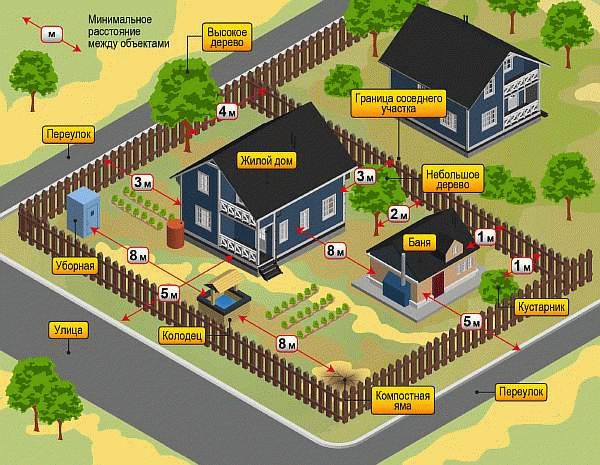
Red line
The previously mentioned property line designation of land is an important factor in determining the feasibility of construction in the selected location.
As a rule, on state territory near private houses there are lighting poles, information signs, etc.
Main gas supply lines, water supply and drainage communications are hidden underground. They are combined with pedestrian paths, and in many cases, highways and local roads.
Construction restrictions make it possible to ensure unhindered 24-hour access to life support lines for the population. The master plan (GPZU) of any settlement contains the exact location of the red lines. If in the documentation submitted for approval the distance from it to the box is less than 5 m, then a negative answer will most likely be received.

There is a high probability that if the construction of a building was carried out without taking into account the distance to the red line, the owner will be forced to demolish it by court decision.
At what distance does the law allow garages to be built from the border of a neighboring property?
According to SNiP, to determine the distance from the garage to the neighboring site, you need to take into account various factors:
- If the neighbor's property is empty, the right of the first developer applies, according to which it is possible to install a garage at a distance of 1 m from the neighboring fence. In this case, you need to make sure that rainwater from the roof of the building does not reach the neighbor, and the passage between the fence and the wall of the garage remains free.
- If the adjacent plot is already built up, the distance from the garage to the neighbor’s house must be at least 6 m. This is necessary to ensure safety in the event of fire or other force majeure circumstances.
- If construction occurs at the same time, or a neighbor is building later, but wants to reduce the distance to the garage on your site, and also in case of mutual violation of SNiP requirements (for example, the side walls of the garages are adjacent to each other along the boundaries of the sites), an agreement is drawn up, certified by a notary. At the same time, each owner is obliged to ensure the drainage of rainwater onto his site.
We advise you to read: “At what distance to install a septic tank.”
Such an agreement becomes retroactive 3 years after its conclusion. If before the expiration of this period one owner sells the plot, the new owner has the right to demand that the garage be moved from the border to a distance corresponding to SNiP standards.

If a neighbor has a development plan, first of all, for a house, this is equivalent to the start of construction. In this case, the distance from the garage to the border of the neighboring plot must be determined as for a built-up type.
Features of the neighborhood with wooden buildings
The proximity to a farmstead where a wooden residential building is built increases the mandatory distance to 15 m. At the same time, the right to agree with the owner on reducing this distance is retained. Consent is drawn up in writing and certified by a notary.
The same procedure for neighbors to resolve the issue applies to brick buildings, if it is necessary to build a room for a car at a distance of less than 6 m. A prerequisite for receiving a positive answer from a neighbor is to ensure sufficient fire safety measures.
This is interesting: The boundaries of the land plot were established more than 15 years ago
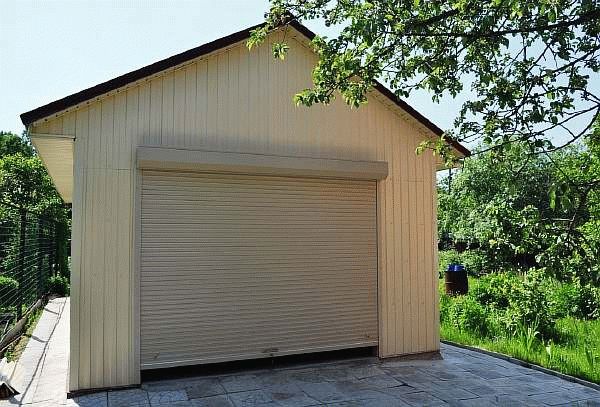
To do this you need:
- install an external shield with recommended fire-fighting accessories;
- place a fire extinguisher in the room;
- ensure that the room is not heated;
- place the electrical power supply distribution panel outside the building;
- equip the electrical panel with an automatic load switch;
- trace the wires in a protective metal sleeve;
- equip lighting devices with factory shades.
If the above recommendations are not followed, you may not only lose the opportunity to resolve the issue peacefully, but also aggravate the situation as a whole. Thus, guided by Article 304 of the Civil Code of the Russian Federation, the owner of a neighboring plot may demand that construction and operation be brought into compliance with fire regulations. Failure to comply with the permitted construction distances is a direct possibility of fire spreading.
Recommendations for choosing a site for construction
In order to have fewer questions when coordinating documentation with the architects of the local administration, the construction of a capital box should be planned taking into account the following:
- If the building is located inside a courtyard area, then the entry of a car should not be accompanied by additional maneuvers.
- There should be enough space on the inside of the entrance gate to lock the garage door.
- The entrance to the garage, if it is adjacent to the street, must be designed to provide sufficient visibility for the safe maneuver of exiting vehicles.
- Opening the gate should not interfere with the movement of pedestrians and passing cars.
- The building should not block the access of light to the neighbor’s vegetable garden or garden if it contains low-growing varieties of trees.
- Water drainage from the roof must be directed to the territory of your site, both from the roof and along the ground using a ditch.
- Planting your own trees is carried out taking into account the requirements of SNiP.
- If you decide to build a garage adjacent to the house or allocate a basement floor for it, then all fire safety standards must be met. They relate to the equipment of the room with a hood, fire equipment, and a fire alarm.

If the garage is located in a private house in the basement, then fire safety rules allow parking and storage of vehicles running on liquid fuel there.
About garage sizes
At the design stage, the internal dimensions of the garage should be provided to ensure minimal comfortable and safe use. They can be:
- on both sides of the car - 0.8 m;
- if there are columns - at least 0.6 m;
- from the trunk and hood of the car - at least 0.7 m;
- with impressive parking dimensions, when parking cars one after another - 0.6 m;
- if parallel parking of two cars is provided, then a width of 1.6 m and a length of 1.4 m are added to the standard dimensions.

About the ceiling height. In accordance with SNiP standards, the ceiling height is taken to be the distance from the surface of the floor covering to the maximum protruding lighting fixture or communication element. The safety gap to the car cannot be less than 0.2 m.
Following the recommendations will not only help you comfortably use the room for its intended purpose, but also in a critical situation.
For example, in the event of a fire, this will allow the evacuation of vehicles and stop the spread of fire.
Litigation
Clarification of relations between neighbors in the courts is an extreme measure used in cases where it is impossible to find mutual understanding. But if it is not possible to dispose of your land to build a garage due to unfounded claims, then there are no other ways to prove your case.
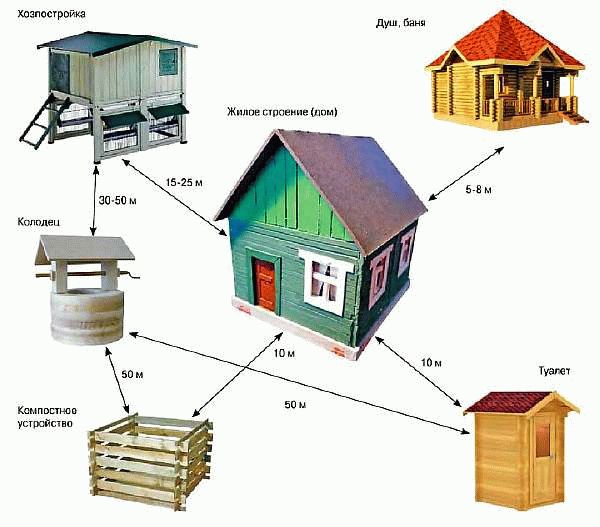
To consider the case in court, the plaintiff prepares and submits a statement of claim accompanied by title documents of a housing nature. Their list duplicates the necessary papers for approval of the project by the administration architects.
The plaintiff also sets out the circumstances and subject of the illegal claims, methods and means of preventing the realization of rights. The statement of claim is supplemented with evidence in the case in the form of photographs and video materials.
Before preparing a statement of claim, you should make sure that there are no violations on the part of the plaintiff, and that the norms for distances from residential and auxiliary premises are met. Otherwise, it will not be possible to count on a positive decision.

How much do you need to step back from the fence when building a garage?
Similar situations often arise that have simple solutions, including:
- The owner built a garage close to the fence, he doesn’t know what to do. The only correct decision is to fulfill all fire safety training requirements and come to an agreement with the neighbor, documenting the absence of objections.
- What distance should you retreat from the fence when building a garage if the red line is 9 meters away? With such a distance from the property line of the land, the minimum distance between the garage and the fence must, by law, be at least 1 meter.
- If a neighbor built a garage from the fence, without retreating, violating the 1 meter standard, and the side wall is located close to the fence, what should you do? If construction took place without approval, then you need to file an application with the court.
- How much should you step back from your neighbor's house if it is wooden and there is no fence around the property? You should focus on the recommended standards - 15 meters. You can install an iron or brick garage after agreement with your neighbor.
- Settlement in the household after its acquisition occurred later than the time the neighbor built the garage; it turned out that the distances were maintained, and the light did not enter the yard. The courtyard is not a vegetable or garden area. Distances have been maintained, and there is nothing to file claims in court for. In this case, all that remains is to redevelop your site as much as possible.
Every year the country's legislation is improved, and SNiP requirements undergo changes. In this regard, to obtain objective information in each specific case, you should seek advice from practicing specialists. This also applies if difficulties arise when independently preparing a project for a future garage.
How many meters to retreat when erecting an individual building on a site is shown in the video below.
Required distances
The permitted footage and the decision of the question at what distance from the fence to build a garage are of approximately equal importance. If we are talking about construction from a neighbor’s fence or from a fence facing the street, the distance may be the same or different.
The garage can be located no closer than 6 meters from the driveway, street, outbuilding and block boundary. You can also count on a minimum distance from the neighbor’s fence, if you managed to come to an agreement with the neighbor, the distance suits him, and he signed a written agreement about this.
If the part of the premises allocated for placing a car is attached, the distance is calculated according to the standards for residential buildings:
- from trees and bushes on a summer cottage in a village - at least a meter;
- from the red line (block boundary, roadway, entrance gate) - 5 m according to the law;
- from your own and neighboring residential buildings, outbuildings in a private house - at least 6 m;
- if there is no building on the neighbor’s property next to the fence - at least 1 m;
- New trees can be planted at a distance of at least 2 m from the fence and from the built garage;
- if the shadow of a garage in the private sector falls on a neighbor’s plot with a vegetable garden, a lawsuit is also possible.
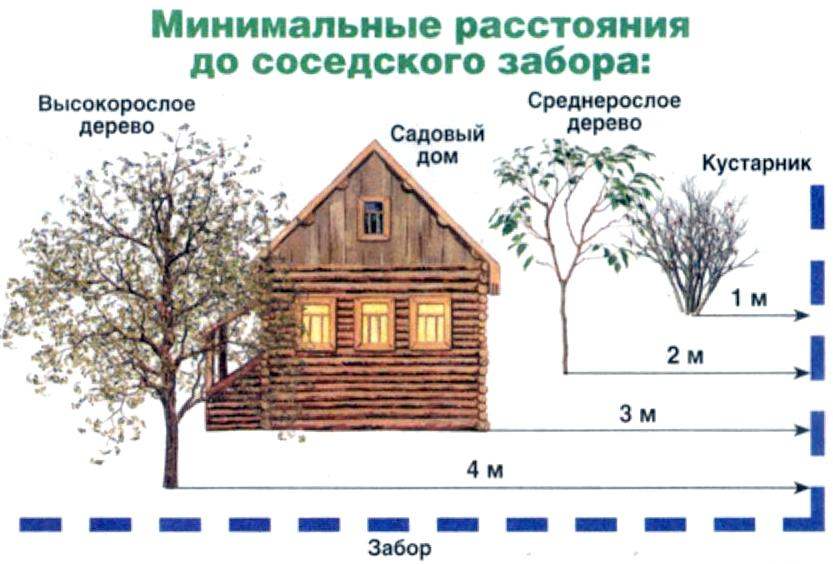
At what distance from the fence can a residential building be built?
The distance is measured not from the base, but from the protruding part of the roof. Scandalous court decisions are widely known when demolition was ordered due to a few centimeters of discrepancy or due to a developer’s mistake in measuring the distance from the foundation, and not from the roof.
Basic fire safety requirements for garages
It’s good when the site is large and convenient. Review the projects, choose the one you need and place buildings, gardens, and yard according to your taste. It is more difficult to equip a small and not very convenient area. It does not matter whether a summer house or a house for permanent residence will be built, such buildings as a barn, garage, summer kitchen, gazebo are always desirable and necessary on private property.
This is interesting: Setback from the border of the individual housing construction plot
Monolithic brick fence combined with a garage
A rational approach to site planning allows you to save space and significantly reduce the cost of landscaping. One of the options for saving space is projects of fences combined with a garage. This method of placing a building has its advantages and disadvantages, its fans and opponents.
The advantages of joint construction include:
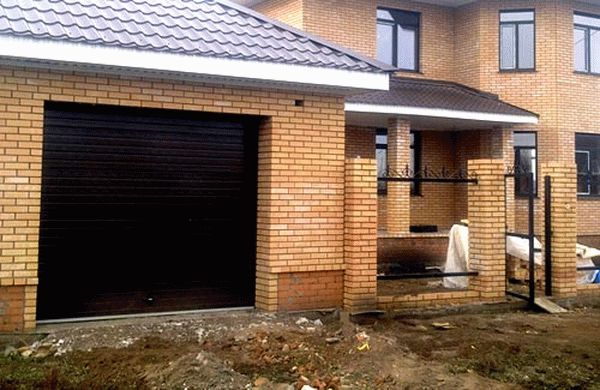
To create a single yard style, a garage and a fence with common boundaries must be made of the same material, in a common style.
Projects for the joint construction of a fence and a garage have an option when a common wall with a gate facing directly onto the street becomes common. In this case, the garage door and the gate are made of the same materials, the same color and design.
The second option is a common side wall, and the garage door is located at some distance from the fence gate. In this case, the costs of building two gates are added, but it is possible to park the car in the yard without a garage.

The garage fits best into a fence made of brick or stone; in this case, they create a single picture. Finishing of both the common wall and the rest is carried out with the same materials. A rich look is created by gates with forging elements.
Another excellent material for this type of placement of buildings is corrugated sheeting. Fences made from it have already become firmly established, and garage designs made from corrugated sheets are an innovation, but quickly adopted by car enthusiasts.
This is the simplest material for building both a garage and a fence on your own, and is also affordable.
Instead of a garage - a canopy to the fence
A common wall makes it possible not to build a permanent structure, but to attach a covered canopy to a high fence. Building a carport is advisable if you have several cars and it is not possible to build a large garage.

Option for a canopy to the fence instead of a garage
Covered parking within the yard can be added to the fence when it is installed, or can be added later. Such a canopy can be placed either immediately after the gate or at any convenient distance. To prevent water and tree branches from getting on the car during heavy rainfall or wind, it is better to plan the parking lot on the side most protected from the wind.
As a material for covered carports, you should choose one that suits your financial capabilities, the design of the yard, and does not create difficulties during installation.
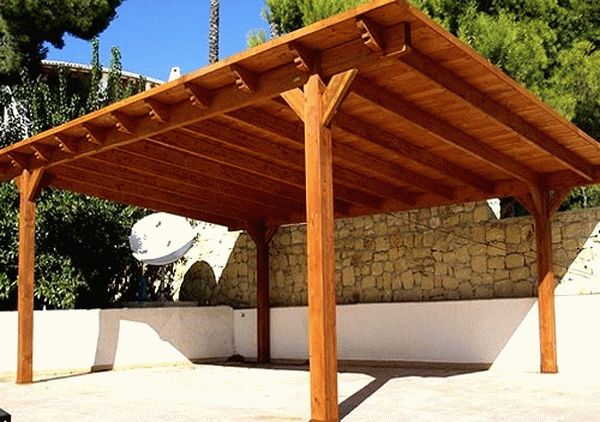
What could be easier than building a garage or erecting a fence? Nothing until you start construction. This is where the questions begin: what distance from the fence to the garage can you choose? Norms? SNiPs? Rules? Calm down, we have prepared a detailed answer about this (and more) in this publication.
Choosing a site for development
You don’t have to decide at what distance from the fence you can build a garage in a private house if the land plot is of impressive size, there are no low areas on it, and there is no immediate proximity to general communications. Recommendations for placing the garage in this case will be something like this:
- it can be built near the road or with an entrance from it;
- build as a separate building not far from the fence;
- as an extension to a utility block or residential building.
The distance in relation to the fence, in any of the selected options, must comply with SNiP standards.
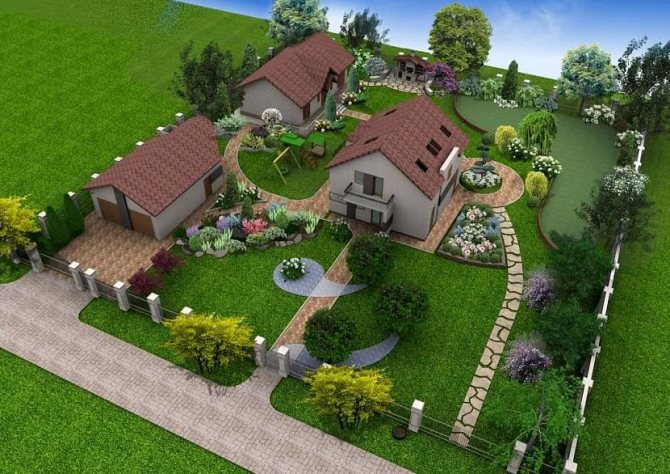
If the size of the plot allows, then there will be no special restrictions on the placement of the garage Source kkp.ru.net
Important clarification! If the total area of the land plot is 6-12 acres, then 30% is allowed to be allocated for the garage. Therefore, in this case, it makes more sense to place it as an extension.
Garage on the property: norms and rules, customs and habits
The construction of low-rise buildings today is not subject to strict construction control and regulation. The homeowner has the right to independently determine the parameters of the house and outbuildings, the location of technical services, the garden, the distance from the fence to the garage. And yet, when solving planning problems, the owner of the site must take into account some norms of Russian legislation. At least in order not to rebuild later, when it turns out that in some way the owner of the site and the house infringed on the rights of the neighbors. This also applies to the rules for choosing a location for a garage on the site.
Our store website provides a larger selection of all components.
At what distance from the fence can you build a garage: study the documents
In order to find out at what distance you can build a garage from a neighbor’s fence or how much you need to retreat from the fence when building a garage, the developer should know documents that are legal and advisory in nature:
- Civil Code of the Russian Federation (Article 51, paragraphs 1 and 17) , which states that there are no legal requirements for a special permit for the construction of a garage on a personal plot.
- SNiP 2.07.91-89 (according to the design documentation of private houses, which qualifies the garage as an outbuilding).
- SNiP 30-02-97 (on the interpretation of some controversial issues).
- Code of Rules (SP) 53.13330.2011 (on the planning and development of dacha associations).
- Rules of TsNIIEP Grazhdanstroy , which develops construction documentation.
- Notarized approvals from neighbors and the owners' association.
- Recommendations from local government (not mandatory).
According to all legislative documents, the garage is listed as an outbuilding and has one condition: the distance from the fence to the garage is 1 meter. But it's not that simple.
When you are building a garage, you need to clarify the distance between the apartment building and the garage. After this, remember that the procedure for obtaining permission to develop a site, project approval, and notarization applies to all buildings, including the garage. After 3 years, the statute of limitations begins, after which claims against the development are no longer relevant.
Look at the diagram below and find out what should be the distance between the garage and the neighbor's fence and the distance from the house to the garage on the site.
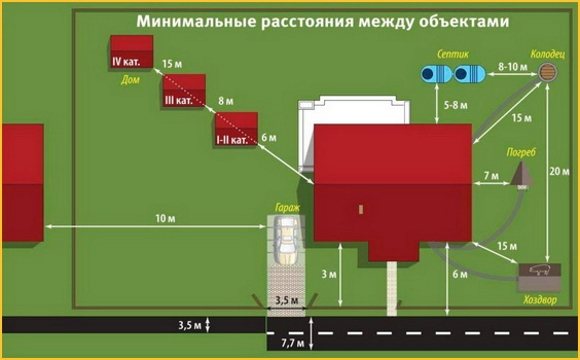
Compliance with safety regulations
The first regulatory document that you need to pay attention to is the law of the Russian Federation dated December 30. 2009 No. 384-FZ “Technical Regulations on the Safety of Buildings and Structures” (hereinafter referred to as Law No. 384-FZ). Basic safety principles relevant to low-rise and homestead construction. Such objects include a garage.

Principle 1. Buildings and structures should not pose a threat of mechanical damage. Buildings and structures should not threaten people with mechanical destruction and injury as a result of these destructions. There should be no threat of mechanical damage to other buildings and engineering structures. As an example, we can consider a situation where a neighbor installs his garage in such a way that the garage door, when opened, destroys the fence of your property. The situation, at a minimum, leads to a scandal between neighbors, and at maximum to a trial.
Principle 2.
During operation and during the construction of houses and premises for economic or technical purposes, fire safety rules must be taken into account. Today, the regulatory approach to low-rise civil construction has been weakened. The fire danger of an object (if it is used for business) in the private household is determined by the owner himself. It is necessary to take into account the rules (SP 42.13330.2011, SNiPs: 2.07.01-89, 02.31.2001, 02.30.97, 2.01.02-85) and fire safety rules established by technical regulations (law dated 07.22.2008 No. 123-FZ, hereinafter referred to as Regulation No. 123-FZ).
Principle 3.
During the construction and operation of buildings, outbuildings (including garages) and engineering support structures, it is necessary to comply with sanitary safety standards and not use materials or technologies that pose a threat to human health.
Principle 4.
Environmental consequences must be taken into account. It is prohibited to harm nature.
Principle 5.
The designs of buildings and structures must be designed for possible natural disasters characteristic of the area where construction is taking place.
Principle 6.
Houses, garages, outbuildings, and structures supporting them should not cause situations leading to injury to people. Houses and outbuildings on the site must be located in such a way as to exclude the possibility of injury to a person.
Principle 7.
Buildings and structures today must be energy efficient. Compliance with this principle (use of modern energy saving technologies) allows the owner to save on operating costs. The owner saves his money and saves natural resources and energy on a national scale.
Today there are no special requirements for buildings such as a garage for one or two cars on the territory of a private household. Compliance with these principles makes it possible to arrange all outbuildings on the site as conveniently as possible, to provide for possible emergency and non-standard situations as much as possible, and to maintain good neighborly relations.
SNIP standards
In accordance with the requirements of SNiP, the location of the building along the facade border and the distance to the garage should be:
- 1 m from bushes;
- 2 m from the trunks of medium-sized plantings (trees);
- 4 m from the trunks of tall trees;
- 3 m from a residential building;
- 1 m from outbuildings.
The main regulatory documents whose provisions must be relied upon when deciding at what distance from the fence a garage can be built are SNiP 30-02-97 and SNiP 2.07.01-89.
Regardless of where the garage is located in a village or city.
The provisions set out in SNiP are advisory, but if complaints are received from neighbors or local governments, then the courts will take as a basis the norms described in SNiP 30-02-97.
Violation of standards does not entail administrative or criminal liability, since they are advisory in nature. But it is necessary to adhere to them so as not to come into conflict with neighbors or local administration.









